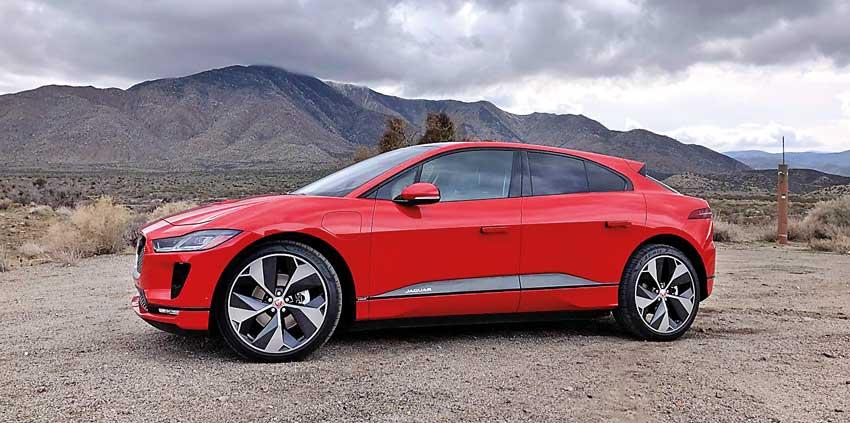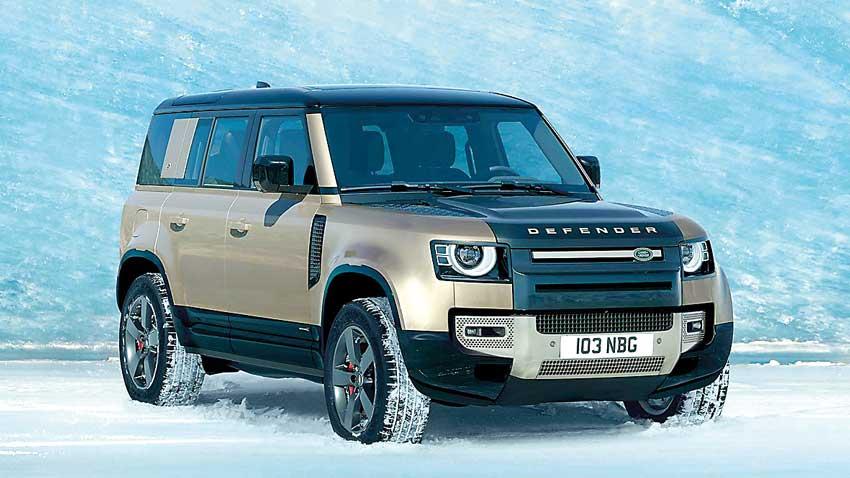17 Mar 2020 - {{hitsCtrl.values.hits}}

Jaguar I-PACE
In an increasingly fast-paced world, disruption can be caused by an ever-growing number of sources. A brand’s ability to navigate this shifting landscape is often contingent on its agility, and its ability not just to respond but effectively drive disruptive innovation.
The impact of continuous improvements in electric vehicles, AI-enabled self-driving cars and an acceleration in the overall rate of innovation across the automotive sector, the future of automobiles is now entering an exciting period of rapid change and innovation.
For luxury brands like Jaguar Land Rover (JLR) that are revered as automotive royalty - being bold on innovation, while staying true to its rich legacy can seem a daunting challenge.
Represented in Sri Lanka by its sole authorised agent, Access Motors, formerly known as SML Frontier Automotive, JLR has recorded outstanding growth in Sri Lankan market share despite drastic fluctuations in exchange rates, importation and taxation policy on vehicles and luxury brands in particular.
Backed by a substantial 8 million USD investment, the company and the JLR brand are gearing up for even greater advancements. We sat down with Access Motors CEO, Ravi Perera, in order to gain some insight into today’s market, and the remarkable strategies which his organisation has leveraged on to navigate its way to success. Following are excerpts:

All New Defender 110
How has auto retail performed in Sri Lanka in the recent past?
Compared to previous years, I think it’s safe to say that it’s been quite a challenging year for vehicle sales in Sri Lanka. Generally we have seen a notable downward trend across the board amounting to a decline of 28 percent Year-on-Year (YoY).
Naturally, the entire sector has been going through a challenging time, but these figures alone do not accurately reflect the total picture when it comes to real demand for vehicles in Sri Lanka. If we look back just 3 years, registrations of vehicles reached an all-time high to the extent where it was even draining foreign exchange reserves. Those numbers were approximately 4 times higher than today.
In the interim, policymakers had taken multiple decisions which actively sought to curtail vehicle imports. While this illustrates the limitations in our national economic capacity, it is also shows us that demand for vehicles – at every level of society – is strong and growing.
When we focus on the luxury vehicle segment where Access Motors has two of the most respected brands in Jaguar and Land Rover, Sri Lankans are still eager to spend but they have to be assured that they are getting the absolute best in quality and performance. That is why even with the imposition of a very high tax we were still getting healthy demand from more discerning customers.
What is the history of Jaguar and Land Rover in Sri Lanka?
Both these brands have a strong historical connect to Sri Lanka going back as far as the 1930s. So, there has always been a strong affinity among Sri Lankans to classic Jaguar cars. Similarly, our people also have a great deal of love and respect for the Land Rover brand, especially for the iconic Defender models of old.
These were vehicles that were synonymous with rugged performance, durability, and ultimate freedom - on or off the road. Even today, there is still immense value and brand recognition as a result. This rich legacy has an important role to play in the aspirational factor associated with both brands.
Access Motors has been heavily involved with the Land Rover brand in Sri Lanka for the past 07 years. In that time I’m proud to say that we have been very successful in building up the brand locally. It was this success and our proven ability not just to sell, but maintain after-sales care at a level on par with their best global standards that secured our principal’s confidence in Access Motors to the extent that they awarded us the agency for Jaguar as well, just 2 years ago.
Since we opened our state-of-the-art showroom on Flower Road, we have seen a 110 percent Year-on-Year (YoY) expansion in sales. This was driven by a remarkable 226 percent YoY spike in sales of Jaguar vehicles and a robust 37 percent YoY growth in sales of Land Rover. While the rich legacy of both brands is a major factor in why Sri Lankans love both of these brands, it’s really the future of Jaguar and Land Rover which has people most excited today.
What have been some of the notable new developments with Jaguar Land Rover?
Globally there have been some major changes that have followed after the merger of the Jaguar and Land Rover in 2008 subsequent to its acquisition by the TATA Group. In order to understand these changes, it’s useful to consider where the brands were positioned in Sri Lanka previously. It was in 2003 that Frontier Automotive was awarded the Land Rover agency by the Ford Group.
That was a time when the entire automotive industry was shifting their focus from pure mechanical improvements to loading their vehicles with accessories and electronics.
While this was a big attraction for customers, in practice, it resulted in highly complex electronics systems that were prone to breakdowns, especially when repairs and maintenance were undertaken outside of specialised workshops.
Over the next decade since the TATA acquisition, the goal posts shifted as manufacturers raced to ensure that these complex functions were made reliable using on-board computers. These enhancements enabled exponential improvements in the reliability of on-board electronics, and gave rise to the remarkable diagnostic and electronic driver assist systems we see today. During this time, we saw bold changes in the design philosophy of JLR. As both brands incorporated parts of the other, we saw Jaguar enter the SUV category while Land Rover took a leaf of out of Jaguar’s sleeker aesthetics, giving rise to some of most popular models in the domestic market such as the Jaguar F-PACE and the Range Rover Evoque.
More recently, we also saw the launch of the very first full-electric SUV in the form of the Jaguar I-PACE, and while we cannot disclose exactly when it will be released, we can confirm that the sleek, high-performance, fully electric Jaguar XJ sedan series is currently in development and will launch at some point in the near future.
Similarly Land Rover has also been working to update its look while enhancing its feel and functionality.
This attempt to balance modern design sensibilities with the passionate cult following for classic models like the Defender is very much at the heart of the new third-generation of Land Rover vehicles. Moving forward, we can expect the first ever full-electric vehicles from Land Rover in the near future so overall it’s a very exciting time
for JLR.
Do you see strong potential for full-electric or hybrid vehicles on Sri Lankan roads at present?
Certainly there is strong demand, but at the same time, people are usually comfortable with what they are familiar with, and for many the gas-aspirated internal combustion engine is what they have learned to drive on, and what they have aspired to for a long time.
While JLR has some powerful options in the hybrid category across both brands, we still find that demand is strongest for traditional vehicles.
However, globally, JLR has long been conscious of the shift towards hybrids and electrics, and even locally, there is a small but definite surge in preference towards these types of vehicles. There is already a sizeable market of hybrids, but given the prestige factor with premium brands, there will be a lag before the majority of customers accept full-electric as the norm.
Of course JLR has invested massively on R&D in this space, and a lot of this investment is directed towards ensuring that the performance DNA inherent in both Jaguar and Land Rover is respected and carried forward through the transition to electric. In fact, Jaguar was the very first established premium automobile manufacturer to announce its own addition to the full-electric category.
Driving experience aside, the other key limiting factor on the potential of such vehicles is in relation to infrastructure. Based on the latest battery technology available, electric vehicles will require fast charging stations at key locations across the country. While some of this infrastructure has been established, more can be done to improve access, while linking it to renewable energy will also be crucial in ensuring that these vehicles are made truly sustainable. These are not changes that can happen overnight, but we are happy to note that progress is being made.
What is your vision for JLR brand in Sri Lanka over the medium-long term?
Overall, as much as Jaguar and Land Rover continue to evolve and change, those who follow these two incredible brands can continue to rest assured that they will always see the same levels of cutting edge design, core characteristics, and sublime performance they have grown to love and respect over the years.
After innovation in electric cars, technology will be the next and greatest frontier for JLR. Over the medium term, this means that you will gradually see all engines start to incorporate some sort of electrification, as we continue to push the envelope on performance in this category. Over the long term we can also expect engines to become smaller, but much more efficient while the materials that we use to build these machines will become sturdier and more light-weight in order to further enhance efficiency.
In terms of technology, JLR has already incorporated a number of driver assist programmes for basic functions like maintaining and switching lanes, parking and parallel parking and more.
However, I would say that we are still a long way from full driver-less AI, although driver assist technology will definitely start radically transforming the overall driving experience. So much so that in 10 years, we may well look back at the lack of AI-assisted driving as being similar to not having power-steering today.
Over that same timeframe, we as a nation also need to look very hard at the examples set by countries like India and Thailand, which have built major manufacturing capabilities domestically. We need to adapt these principles to local conditions – either total manufacturing or at the very least, reassembly and shipping to key regional markets in Pakistan, and even to countries across the African subcontinent.
16 Nov 2024 2 hours ago
16 Nov 2024 2 hours ago
16 Nov 2024 3 hours ago
16 Nov 2024 3 hours ago
16 Nov 2024 5 hours ago